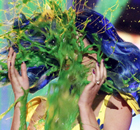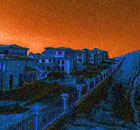Global General
Michelangelo vs. Leonardo?
(China Daily)
Updated: 2010-04-01 08:08
 |
Large Medium Small |
Expert's book chronicles story of 16th-century art contest fought with dueling battle paintings
LONDON - A new book focuses on a 16th-century competition that set out to discover who was the better artist - Michelangelo or Leonardo Da Vinci, and says the outcome profoundly influenced the Renaissance titans' legacies.

Jonathan Jones, a British art critic who has been a Turner Prize judge, said the contest was familiar to art historians but to his knowledge had not been treated as the subject for a book.
The Lost Battles: Leonardo, Michelangelo and the Artistic Duel that Defined the Renaissance, published by Simon & Schuster, hits stores on Thursday and describes a dramatic and defining moment in art history.
The decision by Florence officials that Michelangelo was the victor helped launch the younger artist's career and set him on a path to glory with key commissions in Rome.
Leonardo, meanwhile, was sidelined despite having a more established reputation, and ended up in the French court, which would have been looked down upon by Italy's art patrons.
"You are not left in much doubt that it was a competition," Jones said in a telephone interview. "The Florentine Renaissance was obsessed with competition."
And so, at the turn of the 16th century, the Florentine government commissioned the artists to produce rival battle frescos - Leonardo's Battle of Anghiari and Michelangelo's Battle of Cascina - for a hall in the civic palace.
Neither painting was completed and both are lost, although they survive partially through engravings and sketches. But Jones is in little doubt Michelangelo emerged from the contest with his reputation enhanced while Leonardo suffered a setback.
By presenting Michelangelo as a genius who was working on a great battle painting, the Florentine state helped him secure an even more important commission, the Sistine Chapel, Jones said.
"It was a very important thing that he had trashed Leonardo in this competition and was seen as the greatest artist in history," Jones added. "That was because he had this competition and had won it.
"Yet Leonardo, who was arguably the most famous of them all, doesn't get any of those commissions (to rebuild Rome). He was seen as not delivering in the contest."
History kinder to Leonardo
Jones argues that the fiercely competitive atmosphere of Renaissance art helped spur it to ever greater heights, even if it did damage some careers while helping to launch others.
He also believes that had Leonardo's battle picture been championed in the same way as that of his rival, the history of Italian art may have taken a darker, more disturbing turn.
|
||||
While the two-year contest that ended in 1506 cast Leonardo as the loser, Jones believes history has been kinder to him.
"I've changed my mind so many times in writing this book," Jones said, asked who he thought was the greater of the two.
"These were both incomparable genuises. There is no question that Michelangelo did win, but Leonardo has won historically, just about.
"Michelangelo has been consistently revered, but since Leonardo's notebooks started to be edited and translated and popularized in the 19th century, and we get a sense of Leonardo as a scientist and not just an artist, Leonardo has probably pipped Michelangelo to the post.
"Leonardo, in my heart, ultimately wins."
Reuters










